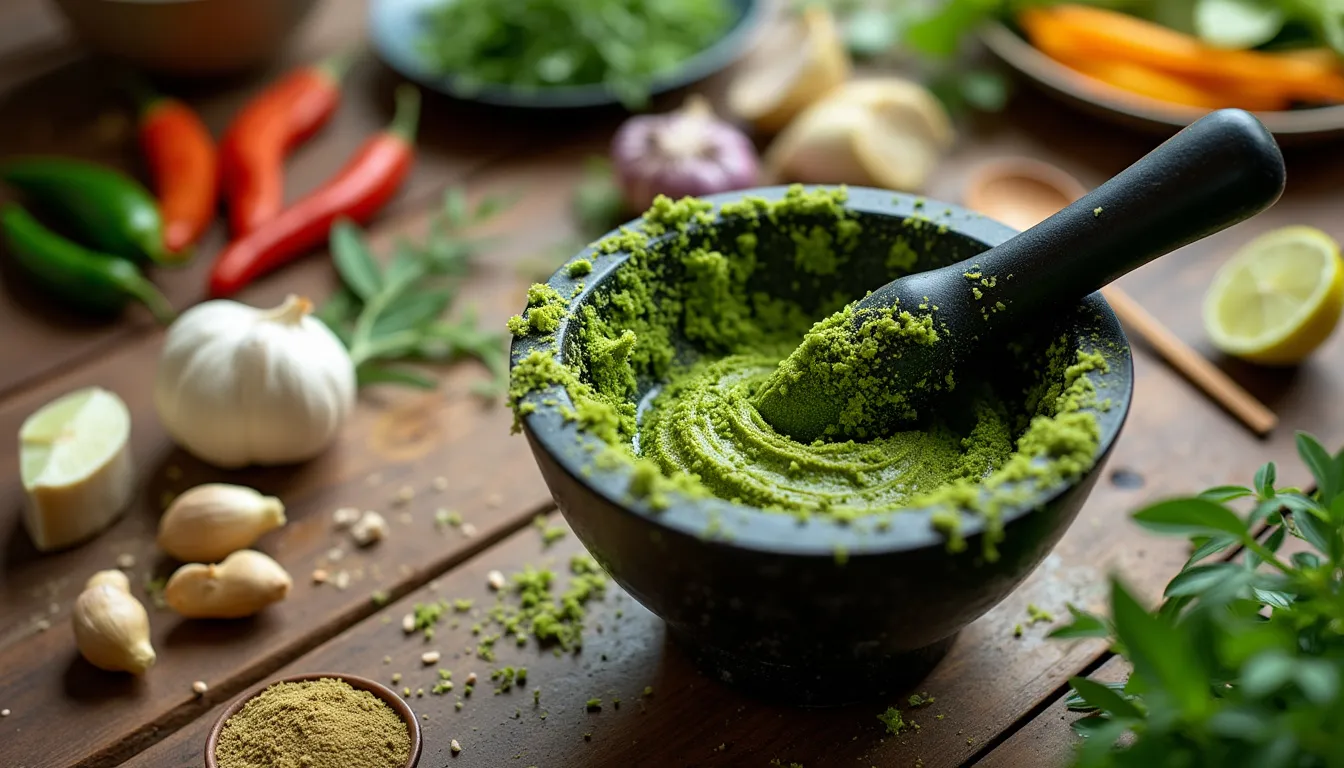How to Make Authentic Thai Green Curry Paste at Home
Embarking on the journey to create your own Thai green curry paste at home can be an exhilarating culinary adventure. Known for its vibrant color and complex flavors, Thai green curry paste is a quintessential ingredient in many beloved Thai dishes. Crafting this paste from scratch not only offers a fresher and more authentic taste but also allows you to control the intensity and balance of flavors. Whether you’re looking to recreate your favorite restaurant dish or explore the depths of Thai cuisine, making green curry paste at home is a rewarding experience that brings the aromatic essence of Thailand right into your kitchen.
Understanding Traditional Thai Spices
Thai green curry paste is renowned for its complex and aromatic flavor profile, which originates from a delectable blend of traditional Thai spices and herbs. The most crucial components of an authentic Thai green curry paste include:
- Green Chilies: These are the heart of Thai green curry paste. The vibrant green color and moderate heat set the tone for this paste’s spicy quotient.
- Lemongrass: Known for its subtle citrusy aroma, lemongrass is indispensable in Thai cuisine, providing a fresh and zesty flavor to the paste.
- Galangal: Often confused with ginger, galangal delivers a sharper and more peppery taste, lending the paste a distinctive, pungent edge.
- Kaffir Lime Zest: The aromatic zest of kaffir lime leaves adds a unique, citrusy fragrance that sets Thai green curry apart from other curries.
- Garlic: Essential for its savory depth, garlic complements the other spices, creating a well-rounded flavor profile.
- Shallots: Adding a slightly sweet, aromatic base, shallots are another staple in the blend.
- Coriander Roots: While the leaves and seeds of coriander are common, the roots offer an earthy, intense flavor unique to Thai curry pastes.
- Fish Sauce: This salty, umami-laden sauce is crucial in capturing the essence of Thai cuisine.
- Shrimp Paste: A pungent yet indispensable ingredient, shrimp paste provides depth and savory complexity.
Where to Source Authentic Ingredients
Finding high-quality, fresh ingredients is key to making an exceptional Thai green curry paste. Here are some tips for sourcing these essential components:
- Local Asian Markets: These markets are treasure troves of authentic ingredients. You are likely to find fresh lemongrass, galangal, and kaffir lime leaves, among other necessities.
- Online Retailers Specializing in Thai Cuisine: When local options are limited, the internet offers an array of specialty stores dedicated to Thai and Southeast Asian ingredients. Websites like ImportFood.com or ThaiTable.com provide authentic, hard-to-find items delivered to your doorstep.
- Farmer’s Markets: While not as comprehensive as Asian markets, local farmers’ markets can sometimes have fresh organic chilies, garlic, shallots, and other herbs.
Substitute Ingredients for Unavailable Items
Despite your best efforts, some ingredients might still be hard to find. Fortunately, some substitutions, while not perfect, can still help you achieve an authentic-tasting Thai green curry paste:
- Green Chilies: If traditional Thai green chilies are unavailable, you can use a combination of green serrano peppers and jalapeños to replicate the heat and color.
- Lemongrass: Lemon zest or lemon balm can be used sparingly as a substitute, although they lack the distinct taste of lemongrass.
- Galangal: Ginger can be used in place of galangal, though the flavor will be slightly different. Use ginger sparingly to avoid overpowering the paste.
- Kaffir Lime Zest: Lime zest or a small amount of chopped lime leaves can substitute kaffir lime zest, though they might not offer the same level of intensity.
- Coriander Roots: If coriander roots are unavailable, use cilantro stems and a bit more of the cilantro leaves for a somewhat similar flavor profile.
- Shrimp Paste: In absence of shrimp paste, fish sauce or anchovy paste can be used, though the unique taste of fermented shrimp might be slightly compromised.
While substitutes may not fully capture the traditional depth of flavor, they can help you come quite close and allow you to enjoy a delightful homemade Thai green curry paste.
Step-by-Step Guide to Making Thai Green Curry Paste
Preparation and Cleaning of Ingredients
Creating an authentic Thai green curry paste starts with properly prepping and cleaning your ingredients. Each component brings its unique aroma and flavor profile, so it’s important to handle them with care. Begin by de-seeding your green chilies unless you want a particularly spicy paste. Simply slice the chilies open and scrape out the seeds with a spoon. Next, turn your attention to fresh lemongrass. Remove the tougher outer layers until you reach the tender, aromatic core, then finely chop it, as you’ll need about 2-3 stalks.
Galangal, which is a close relative of ginger, adds a peppery, citrusy note. Unlike ginger, galangal has a tougher skin that should be peeled using a spoon or knife. Thinly slice about 1-2 inches to make it easier to blend later. Kaffir lime zest follows; you can use a zester or the fine side of a grater to gather about a teaspoon of this aromatic zest. Don’t forget garlic and shallots; peel and roughly chop 5-6 cloves of garlic and 2-3 shallots.
Traditional Methods vs. Modern Convenience
Traditionally, Thai green curry paste is made using a granite mortar and pestle, which effectively releases the natural oils and essences of the herbs and spices, enhancing the paste’s flavor. The rhythmic grinding motion, combined with the coarseness of the pestle, produces a fine, aromatic paste. Although it requires more effort, many Thai cooks believe it results in a richer, deeper taste.
However, if you’re short on time, a food processor is a convenient alternative. Modern technology allows you to blend ingredients into a smooth paste with minimal effort. The main advantage of using a food processor is speed and ease, though some purists argue that the texture and flavor aren’t as authentic. To balance this, consider lightly bruising tougher ingredients like lemongrass and galangal with a rolling pin before blending.
Combining Ingredients to Perfection
Now, let’s bring everything together. Here is a step-by-step process to create your own Thai green curry paste:
- Gather Your Prepped Ingredients: Ensure you have the following: 10-12 green chilies (de-seeded), 3 chopped lemongrass stalks, 2 inches of sliced galangal, 1 teaspoon kaffir lime zest, 5-6 garlic cloves, 2-3 chopped shallots, 1 teaspoon roasted coriander seeds, 1 teaspoon cumin seeds, and a pinch of salt.
- Start with Dry Ingredients: If using a mortar and pestle, begin by grinding the roasted coriander seeds, cumin seeds, and salt to a fine powder. This creates a flavorful base for your paste. If using a food processor, you can add these directly with other ingredients.
- Add the Aromatics: Gradually incorporate the garlic, shallots, galangal, lemongrass, and kaffir lime zest. If using a mortar and pestle, add these ingredients in batches, pounding until each is fully integrated before adding the next. For a food processor, place all these ingredients in at once and blend until smooth.
- Incorporate the Green Chilies: Finally, add the green chilies to your mix. If using a mortar and pestle, continue to pound until you achieve a uniform, thick paste. In a food processor, you’ll want to blend until the paste reaches your desired consistency.
- Check Consistency: Your paste should be thick and cohesive, not runny. If it appears too dry, you can adjust the consistency with a tiny splash of water or vegetable oil. However, add sparingly to avoid diluting the intense flavors.
Remember, the goal is to blend these diverse flavors into a harmonious paste that can be the cornerstone of many delicious dishes.
Storing and Using Your Homemade Thai Green Curry Paste
Proper Storage Techniques
Once you’ve made your aromatic and flavorful Thai green curry paste, it’s essential to store it correctly to maintain its freshness and potency. The richness of the paste comes from the fresh herbs and spices, which can degrade over time if not properly stored. Here are some tips to help you keep your homemade Thai green curry paste at its best.
First, place your curry paste in an airtight container to prevent exposure to air, which can cause the paste to lose its vibrant flavors. For short-term use, you can store the container in the refrigerator. Typically, Thai green curry paste can last up to one week in the fridge. However, if you intend to keep it for a longer period, freezing is the best option.
To freeze the paste, you can use ice cube trays for easy portioning. Simply spoon the paste into the trays and freeze until solid. Once frozen, transfer the curry paste cubes into freezer bags or airtight containers. This way, you can conveniently use small amounts of the paste whenever you need it. Frozen Thai green curry paste can last up to three months without losing its flavor. Always label your containers with the date of preparation to keep track of their freshness.
Recipe Ideas and Usage Tips
Thai green curry paste is incredibly versatile and can be used in a wide variety of dishes beyond the traditional Thai green curry. Here are some creative ways to incorporate this flavorful paste into your daily cooking:
Classic Thai Green Curry
The most obvious use of your homemade curry paste is in the classic Thai green curry. Cook chicken, beef, pork, or tofu with coconut milk, vegetables, and around two tablespoons of your curry paste. Serve with jasmine rice for an authentic Thai experience.
Thai Green Curry Soup
Create a warming, fragrant soup by combining chicken or vegetable broth with coconut milk and your curry paste. Add your choice of protein, noodles, and vegetables. Garnish with fresh cilantro and lime for a delightful meal.
Green Curry Stir-Fry
For a quick and easy meal, use your Thai green curry paste as a base for a stir-fry. Sauté vegetables, tofu, or meat with a spoonful of curry paste. Add a splash of coconut milk and some soy sauce for a delicious, well-rounded dish.
Green Curry Fried Rice
Transform leftover rice into a vibrant meal by frying it with Thai green curry paste, eggs, and vegetables. Add some fish sauce and fresh basil to elevate the flavors.
Green Curry Marinade
Use your paste as a flavorful marinade for meats, seafood, or tofu. Marinate your protein for at least an hour before grilling or baking for a smoky, spicy twist.
Green Curry Dipping Sauce
Mix Thai green curry paste with yogurt or coconut cream to create a unique dipping sauce for appetizers like spring rolls, grilled vegetables, or chicken skewers.
Health Benefits and Nutritional Value
In addition to its incredible taste, Thai green curry paste boasts several health benefits thanks to its fresh, natural ingredients. Here are some nutritional highlights of key components:
Green Chilies
Green chilies are rich in vitamins A and C, which are essential for maintaining healthy skin, vision, and immune function. They also contain capsaicin, a compound known for its metabolism-boosting and pain-relieving properties.
Lemongrass
Lemongrass is packed with antioxidants and has anti-inflammatory properties. It’s also known for aiding digestion and providing relief from digestive issues.
Galangal
Galangal, similar to ginger, has powerful anti-inflammatory and antioxidant effects. It supports digestive health and can help fight nausea.
Kaffir Lime Zest
Kaffir lime zest adds a burst of refreshing flavor and is a good source of vitamin C. It also has antibacterial properties that can support oral health and enhance immunity.
Incorporating Thai green curry paste into your diet can provide these nutritional benefits and contribute to a balanced and flavorful meal plan. Whether you’re making traditional dishes or experimenting with new recipes, your homemade Thai green curry paste is a delicious way to enhance your cooking while nourishing your body.
Conclusion
Creating your own Thai green curry paste at home is a rewarding endeavor that brings the vibrant and aromatic flavors of Thai cuisine straight into your kitchen. By understanding the essential ingredients, such as green chilies, lemongrass, galangal, and kaffir lime zest, you can ensure your paste is as authentic as possible. Sourcing these ingredients from local Asian markets or reliable online retailers will further enhance the authenticity of your curry paste, while substituting when necessary with careful consideration to maintain the unique taste.
The step-by-step guide provided ensures that you can efficiently and effectively prepare your ingredients, whether you choose the traditional or modern method of combining them. Once prepared, proper storage techniques allow you to preserve the fresh, bold flavors of your paste for future use. Additionally, the versatility of Thai green curry paste allows it to be a dynamic element in various dishes, from the classic Thai green curry to creative fusion recipes.
Beyond its remarkable taste, Thai green curry paste is packed with nutritional benefits, making it a healthy addition to your meals. The use of fresh herbs and spices not only enhances flavor but also contributes to a balanced diet. As you incorporate this homemade curry paste into your culinary repertoire, you’ll not only enjoy its delightful flavors but also the satisfaction of crafting a key component of Thai cuisine from scratch.
Whether you’re a seasoned cook or a culinary novice, this guide has provided you with the knowledge and confidence to create and use your own authentic Thai green curry paste, enriching your cooking experiences and delighting your taste buds with each use.







